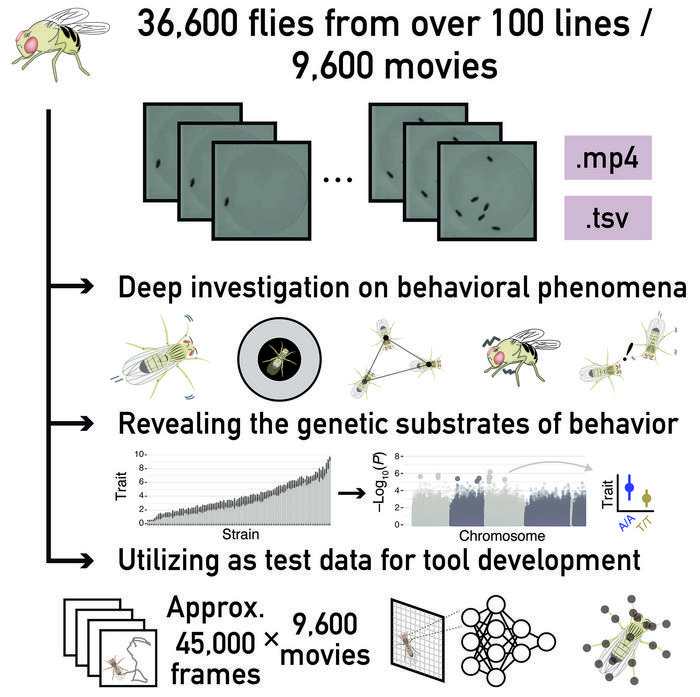In a groundbreaking study, researchers led by Assistant Professor Daiki Sato from Chiba University, Japan, have unveiled an extensive dataset that explores the intricate connection between genetics and behavior in fruit flies, scientifically known as Drosophila melanogaster. This research provides invaluable insights into how genetic variations can shape behavioral responses to both social interactions and simulated threats, such as predatory stimuli. Given the significance of fruit flies in genetic research—due to their genetic similarities to humans—this dataset sets a new standard for understanding the biological foundations of behavior.
The motivation behind this project stemmed from the quest to decipher the complexities of behavior that arise from genetic influences. Despite the tremendous advances in genomics, the link between genetic makeup and resulting behaviors often remains elusive. Traditional models have always struggled with the nuanced nature of behavior, necessitating a shift to more manageable organisms like fruit flies. These insects not only share several genes related to human diseases but also reproduce rapidly, thus offering an excellent platform for large-scale behavioral studies without the logistical constraints typically faced with more complex organisms.
The research team meticulously designed their study around a behavioral dataset encompassing over 30,000 individual fruit flies across 105 genetically distinct strains. This collection included an impressive variety—104 wild-type strains and a unique visually impaired mutant strain. The dataset aims to bridge previous gaps in behavioral research by facilitating detailed analyses of how genetics influences locomotion, fear responses, and social interactions.
Over a series of 15-minute observation sessions, the researchers recorded the movements of the flies in controlled environments, allowing rigorous analysis of their varied behavioral traits under both isolated and group conditions. Notably, simulated threats in the form of looming stimuli—dark circles representing approaching predators—provided critical insights into the defensive and social responses of the flies. This methodological design ensured that the study could analyze behaviors in a contextually rich manner, simulating real-life challenges these insects might encounter in the wild.
Utilizing advanced tracking software, the researchers were able to quantify a diverse set of behavioral metrics. They measured movement speed, the duration spent in different areas of the observation arena, and the distance maintained to nearest neighbors—all crucial factors linked to bravery, social behavior, and stress responses. The analysis revealed a remarkable spectrum of behaviors categorized by genetic background, sex, and social context, which led experts to further explore the implications of genetic variability on behavior.
Dr. Sato emphasized the importance of this comprehensive dataset, stating that it allows researchers to expand their understanding of the interactions between individual genetics, environmental factors, and the subsequent variations in behavior. By documenting these variations across a range of contexts, the research paves the way for significant developments in fields ranging from evolutionary biology to neuroscience. This understanding could eventually lead to breakthroughs in mental health treatment, offering a genetic perspective on behavioral conditions.
Furthermore, the dataset is particularly suited for genome-wide association studies (GWAS). This analytical approach can help pinpoint specific genetic variations linked to distinct behavioral traits, enhancing our understanding of how genetics contribute to the manifestation of actions and reactions. By including genetically identical strains, the study uniquely illustrates how non-genetic factors can also influence behavioral outcomes.
The implications of this research extend far beyond fruit flies. By establishing a framework for analyzing the genetic basis of behavior, the methodology can be adapted to more complex systems, including mammalian models and even humans. With mental health issues increasingly recognized for their genetic components, insights derived from this research could inform treatment methodologies and deepen our understanding of psychological phenomena.
Another noteworthy aspect of this study is its contribution to the toolkit of image analysis and tracking software. The compelling combination of detailed behavioral observations and genetic analysis fosters a richer understanding of how animal behavior is influenced, nurturing the development of new technologies for behavioral tracking and analysis. As the quest for understanding behavioral genetics continues, such datasets will prove essential for future explorations and discoveries.
By connecting genetics with behavioral science, this research heralds a new era of inquiry into the complexities of behavior. Bridging the gap between gene and behavior not only enriches the basic scientific knowledge but also lays the groundwork for practical applications in mental health. In an age where genetics is often seen as a determining factor of identity, this research offers a tremendous opportunity to rethink how we understand behaviors shaped by both genetic and environmental contexts.
As scientists continue to scrutinize the intricate dance between genetics and behavior, studies like those of Dr. Sato’s showcase the vital role of model organisms such as Drosophila melanogaster. The innovative methodologies and vast datasets refined here signal progress toward not only answering longstanding questions in biology but also forging critical connections with future healthcare advancements.
Subject of Research: Animals
Article Title: Multifaceted and extensive behavioral trajectories of genomically diverse Drosophila lines
News Publication Date: 7-Mar-2025
Web References: https://doi.org/10.1038/s41597-025-04724-3
References: 10.1038/s41597-025-04724-3
Image Credits: Credit: Assistant Professor Daiki Sato from Chiba University, Japan.
Keywords: Genetics, Behavior, Drosophila melanogaster, Dataset, Social Interaction, Genome-wide association studies, Mental health, Behavioral science, Evolutionary biology.




